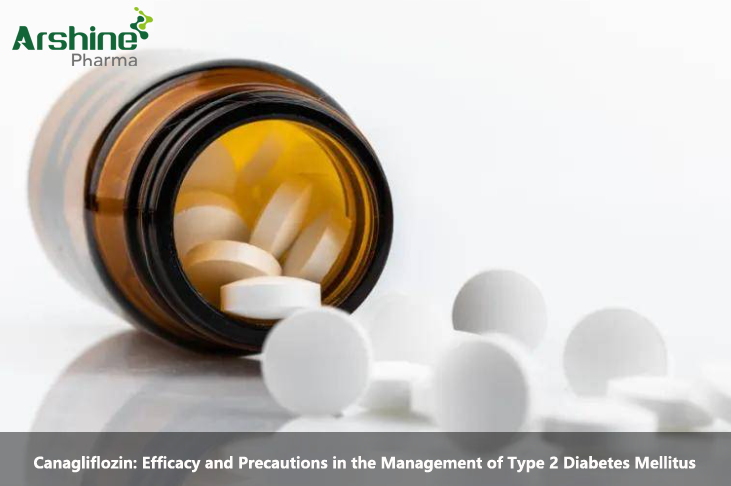
Introduction: Canagliflozin is an oral antidiabetic medication belonging to the class of sodium-glucose cotransporter 2 (SGLT2) inhibitors. It is used in the management of type 2 diabetes mellitus (T2DM) to improve glycemic control and reduce the risk of cardiovascular events. Canagliflozin works by inhibiting SGLT2 in the kidneys, thereby reducing glucose reabsorption and promoting glucose excretion through the urine. This article provides a comprehensive review of canagliflozin's efficacy, mechanisms of action, and precautions to ensure its safe and effective use in patients with T2DM.
-
Mechanisms of Action: Canagliflozin inhibits SGLT2, a protein responsible for reabsorbing glucose from the glomerular filtrate in the kidneys. By inhibiting SGLT2, canagliflozin reduces glucose reabsorption, leading to increased urinary glucose excretion (glucosuria). This mechanism of action lowers blood glucose levels independently of insulin, making it particularly beneficial in patients with T2DM who may have insulin resistance or reduced insulin secretion.
-
Efficacy in Glycemic Control: Clinical trials have demonstrated the efficacy of canagliflozin in improving glycemic control in patients with T2DM. It can effectively reduce hemoglobin A1c (HbA1c) levels, fasting plasma glucose (FPG), and postprandial glucose levels. The combination of canagliflozin with other antidiabetic agents, such as metformin or sulfonylureas, has shown additive effects in lowering blood glucose levels.
-
Cardiovascular Benefits: Canagliflozin has demonstrated cardiovascular benefits in patients with T2DM. Large clinical trials have shown that canagliflozin reduces the risk of major adverse cardiovascular events (MACE), including cardiovascular death, nonfatal myocardial infarction, and nonfatal stroke. Additionally, canagliflozin has been associated with a reduced risk of heart failure hospitalization.
-
Renal Benefits: Beyond glycemic control, canagliflozin has shown renoprotective effects. Studies have indicated that canagliflozin reduces the progression of diabetic nephropathy and slows the decline in glomerular filtration rate (GFR) in patients with T2DM and chronic kidney disease (CKD). The reduction in intraglomerular pressure due to decreased glucose reabsorption contributes to its renoprotective effects.
-
Precautions and Contraindications: a. Hypoglycemia Risk: While canagliflozin does not typically cause hypoglycemia when used as a monotherapy, the risk of hypoglycemia increases when combined with other antidiabetic agents, such as sulfonylureas or insulin. Patients taking multiple antidiabetic medications should be carefully monitored for signs of hypoglycemia.
b. Volume Depletion and Hypotension: Canagliflozin's mechanism of action leads to increased urinary glucose excretion, which can be associated with osmotic diuresis and volume depletion. Patients with a history of dehydration, hypotension, or those taking diuretics should use canagliflozin with caution to avoid exacerbating volume-related adverse effects.
c. Ketoacidosis Risk: SGLT2 inhibitors, including canagliflozin, have been associated with an increased risk of diabetic ketoacidosis (DKA), particularly in patients with precipitating factors such as infection, reduced caloric intake, or alcohol consumption. Patients should be educated about recognizing the signs and symptoms of DKA and advised to seek medical attention promptly if they occur.
d. Genital Mycotic Infections: Canagliflozin's mechanism of action increases urinary glucose excretion, providing a favorable environment for fungal growth. As a result, genital mycotic infections, such as yeast infections, are more common in patients taking canagliflozin. Patients should be informed about preventive measures and appropriate management if such infections occur.
e. Lower Limb Amputations: Some clinical trials have reported a slightly higher risk of lower limb amputations, particularly of the toe, in patients taking canagliflozin. The risk factors for amputations, such as peripheral vascular disease or foot ulcers, should be carefully assessed before initiating treatment with canagliflozin.
f. Pregnancy and Breastfeeding: The safety of canagliflozin use during pregnancy and breastfeeding has not been established. Canagliflozin is not recommended for use in pregnant or breastfeeding women, and alternative treatments should be considered for these populations.
-
Drug Interactions: Canagliflozin has a low potential for significant drug interactions. However, it is essential to consider possible interactions with medications that affect renal function or alter glucose levels, such as diuretics or other antidiabetic agents. Close monitoring of blood glucose levels and renal function is advised when canagliflozin is used concomitantly with other medications.
-
Adverse Effects: Common adverse effects of canagliflozin include urinary tract infections, polyuria, and increased urination. Genital mycotic infections and dehydration-related symptoms, such as dizziness and hypotension, may also occur. Patients experiencing any adverse effects should promptly report them to their healthcare provider.
-
Monitoring and Follow-Up: Regular monitoring of HbA1c, FPG, blood pressure, and renal function is crucial during canagliflozin treatment. Healthcare providers should evaluate the patient's response to therapy and assess for any adverse effects or changes in clinical status.
Conclusion: Canagliflozin is an effective and well-tolerated oral antidiabetic medication used in the management of T2DM. Its mechanism of action, particularly in inhibiting SGLT2 and increasing urinary glucose excretion, offers benefits beyond glycemic control, including cardiovascular and renal protection. However, precautions should be taken to minimize the risk of adverse effects, such as hypoglycemia, volume depletion, and genital mycotic infections. Patients with specific risk factors, such as a history of lower limb amputations or dehydration, require careful consideration before initiating canagliflozin treatment. Close monitoring and regular follow-up with healthcare providers are essential to optimize the safe and effective use of canagliflozin in the management of T2DM. Continuous research and ongoing pharmacovigilance efforts will further enhance our understanding of canagliflozin's efficacy and safety, maximizing its therapeutic potential for patients with T2DM.
